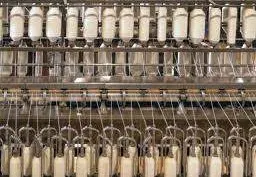Introduction
In
Bangladesh, 19 spinning mills are producing synthetic, 8 mills are producing
Acrylic and rest 406 mills are purely ring-spun spinning mill mainly producing
100% cotton yarn and some quantity of blended yarn.
What is spinning?
Spinning
is the technique of twisting where the fiber is drawn, rolled, and wound on a
bobbin. The yarn issuing from the drafting, rollers pass through a
thread-guide, round a traveler that is free to rotate around a ring, and then
onto a tube or bobbin, which is carried on a spindle, the axis of which passes
through the center of the ring. The spindle is driven and the traveler is
dragged around a ring by the loop of yarn passing round it.
 |
| Spinning |
Government rules in a spinning mill
a.
If the RMG industry uses Bangladeshi yarn, the Bangladesh government will
provide a 5% cash incentive.
b.
The raw cotton import Duty, VAT, AIT everything is Zero.
c.
The Land Border is not permitted to import any Cotton yarn, which is also helpful
for the compatibility of the local spinning mill.
d.
All of the capital machinery and initial raw material is imported duty-free for
the Bangladeshi spinning mill.
e.
Once the Bangladesh government stops to above support then immediately 50% of the spinning mill will lose their business competency in this sector.
The present condition of spinning mill
a.
In the spinning sector, most of the mills invest a huge amount of money for
brand new capital machinery (Europe and japan origin) but mostly producing 20/1
to 30/1 carded yarn. It can be mentioned that the technical expert of this
sector misguided the investor to produce low-end products from a higher price
capital machine.
b.
By using the same fiber Bangladeshi spinning mill manufacturing cost is at least 5% higher than India, China, and Pakistan.
c.
For the 40/1 and above count, the Bangladeshi spinner manufacturing cost is
almost 50 Cents/kg is higher.
d.
The productivity per spindle for an average count (30/1) is around 180 gm./spindle/shift
in Bangladesh and India, this is 220 gm./spindle/shift.
e.
In the Bangladesh process 30/1 viscose yarn is wasted for making about 6% but
in China, it is less than 1%.
Demand for yarn
a.
In Bangladesh handloom products mostly required 50/1 and 60/1 and higher count
cotton yarn. And this product is mostly imported from abroad in both legal and
illegal ways.
b.
There is a huge demand for 100% viscose yarn (30/1 viscose) in local items,
which are mainly imported from ships in the form of yarn, as well as finished
fabric imports.
c.
There is also a big requirement of 50/2 spun polyester yarn as well as regular
spun polyester yarn.
d.
The contribution of local spinning mills to the sweater industry is also very
poor.
e.
The 80/2 and 100/2 cotton yarn mercerized products can affordable by domestic
consumers.
Conclusion
Spinning
is a very important part of textile yarn manufacturing. Without spinning yarn
not proper use.








0 Comments